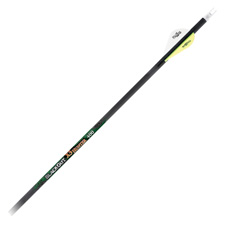
I consider myself a traditional bow hunter. I love my longbow; I don’t use sights; I hunt from the ground; and generally I conduct myself within the spirit of the sport.
But I part ways with tradition when it comes to arrows. I use carbon shafts.
 |
| One reason the author will stray from "traditional" is that carbon arrows are less affected by environmental conditions. |
For many traditionalists, this is akin to heresy. Wooden arrows worked for those early bowhunters; they should be good enough for us, I’m told.
That’s true. A well-made set of wooden arrows are as good as anything else that you can shoot from a longbow or recurve, better if you consider individuality and beauty.
I appreciate wooden arrows as well as the next guy and acknowledge their advantages — they’re surprisingly tough, they’re heavy, which promotes penetration, and are easy on the eye when assembled by one of the many craftsmen out there.
But here are my problems: They're not accessible enough; they shoot slower than carbon; and they are affected by environmental conditions.
The first part is straightforward. If I want a carbon arrow that matches my bow, I can find them and get them that day. If I want a quailty set of wooden arrows, I have to make my own or order from a custom arrow maker and wait a couple of weeks. Either way, I have to take it on faith that I ordered the right spine and got a well-matched set.
If I lived closer to a good arrow maker or had the time to perfect the craft, I’d go the wood route. But, like many, this isn't my situation right now.
The speed issue is interesting because we're talking about traditional bows.
Regardless, I feel an archer should try to maximize the potential of his or her bow. The few extra feet per second I gain from my carbon arrows and fast flight string does make a difference at the range and in the field in terms of flatter trajectory and more consistent accuracy throughout hunting ranges. Taking advantage of this is just being practical.
The other advantage of factory-made arrows over wooden ones is that you can choose from a wider variety of broadheads and screw in points. And while there are plenty of broadheads for wooden arrows, most need to be brought to a razor's edge by the hunter, which is something I'm quite capable of doing, but something I'd rather not, given the choice. Call me lazy, but a broadhead that's shaving sharp straight out of the box appeals to me. Sure, I'll touch it up when it dulls down but I want to start with a scary sharp factory edge. Heck, call me modern, but I even appreciate replaceable blades. Again, I'm just being practical.
The last issue, regarding wooden arrows is most important: They're affected by their environment. Damp conditions, improper storage, age or high and low temperatures can alter their straightness and reliability. And the fact that even the best wooden arrows start with looser tolerances makes this even more of a concern for me.
Carbon arrows, on the other hand, are produced with tight tolerances and never affected by any of these things. They're either as straight as they were when they were produced or broken. Aluminum arrows, by the way, have much of the same advantages as carbon, other than this. They can be imperceptibly bent and the only way you’ll know it is by the way the arrow shoots.
So have I forsaken my traditional stance with arrows? Purists might say so. But I'd argue that any of those old bowhunting icons would have done the same. After all, they knew that the arrow is the most important part of the archery equation. And they went to great lengths to get matched sets of consistently-spined arrows.
I’m all for tradition but sometimes, you just have to keep up with the times.
- 4339 views

